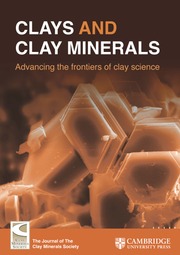No CrossRef data available.
Article contents
Factors governing Fe2+-catalyzed transformation of ferrihydrite associated with kaolinite under anoxic conditions
Published online by Cambridge University Press: 20 November 2024
Abstract
Fe2+-catalyzed transformation of poorly crystalline ferrihydrite into highly crystalline forms is critical in the biogeochemical cycles of Fe, nutrients, and trace elements. The co-existence of ferrihydrite and kaolinite is widespread in soils of tropical and subtropical regions. In this investigation, three associations of ferrihydrite–kaolinite with ratios of 10, 30, and 50% (10% Fhy–Kln, 30% Fhy–Kln, and 50% Fhy–Kln) were examined to study the impact of the initial Fe2+ concentration and pH on Fe2+-catalyzed transformation under anoxic conditions. The findings reveal that the ferrihydrite in the 10% Fhy–Kln associations has the smallest particle size and the largest number of surface hydroxyl groups. At 0.5 mM Fe2+ and pH 7.5, ferrihydrite underwent transformation into lepidocrocite, with the presence of kaolinite promoting the formation of goethite. Moreover, the presence of kaolinite influenced the morphology of the resulting transformation products. A decrease in pH hindered the transformation of ferrihydrite, while an increase in Fe2+ concentration resulted in the formation of magnetite. The impact of kaolinite in the association system on the transformations of ferrihydrite occurs primarily through alteration of the properties of ferrihydrite during its formation process.
- Type
- Original Paper
- Information
- Copyright
- © The Author(s), 2024. Published by Cambridge University Press on behalf of The Clay Minerals Society



